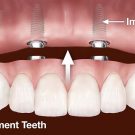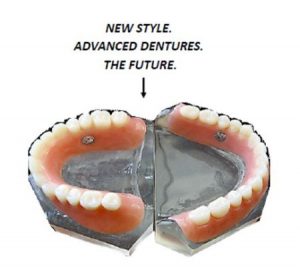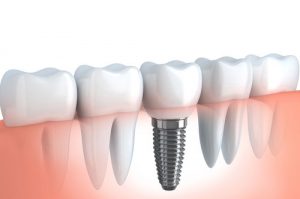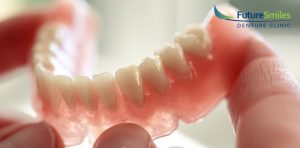Dentures Of The Future May Be Real Teeth

By AMANDA ONION
August 30, 2018
www.abcnews.go.com
In 1781, the soon-to-be U.S. president George Washington wrote to his doctor requesting “a pair of pincers to fasten the wire of my teeth.”
His “teeth” were false and had been hand-carved from hippopotamus ivory and cow’s teeth, then fastened to his mouth with a set of metal springs.
Dentures have, of course, come a long way since then. And new research promises access soon to something far more advanced than hippopotamus choppers — real human teeth, grown in laboratory dishes.
 Scientists also hope that by locating the right biological triggers, people may one day be able to grow several sets of teeth instead of just two — much like the way sharks, rodents or stingrays grow several generations of teeth to replace worn out or rotted ones.
Scientists also hope that by locating the right biological triggers, people may one day be able to grow several sets of teeth instead of just two — much like the way sharks, rodents or stingrays grow several generations of teeth to replace worn out or rotted ones.
“Nature has developed over a long time certain tissues that have a particular function,” says Mary MacDougall, associate dean of the dental school at the University of Texas Health Science Center. “So there’s nothing like being able to use the real thing.”
Tooth Parts in a Petri Dish
MacDougall has managed to grow the real thing, or at least parts of it, in her laboratories at the University of Texas. She and her students first dissected tissues borrowed from extracted wisdom teeth. Then they added extra genes to the tissue cells that make up the tooth’s outer shell, enamel and its inner hard surface, dentin so the cells would continue to replicate in culture. After nurturing these cells in moist conditions, the team soon had human tooth parts growing in culture.
“We have little factories that make the natural enamel and dentin for us in a dish,” she says.
Unlike most bones in the human body, tooth enamel is made up of cells that die off as the tooth forms. That’s why when enamel tissue rots, dentists replace it with fillings. MacDougall says new filling materials such as amalgam and plastics are often tested first on lung cell tissues since these cells reproduce well in culture.
She hopes developers can soon test new filling materials in lab-grown tooth tissues. And if all goes according to plan, filling tests would become obsolete since dentists will be able to grow real tooth enamel fillings in the lab.
 That prospect, MacDougall says, is at least a decade away. Even farther away — about 20 years — is the prospect of triggering cells still in the mouth to regrow teeth. To do that, scientists must first find the genes and proteins that regulate the tooth-growing process.
That prospect, MacDougall says, is at least a decade away. Even farther away — about 20 years — is the prospect of triggering cells still in the mouth to regrow teeth. To do that, scientists must first find the genes and proteins that regulate the tooth-growing process.
As Harvard University geneticist, Richard Maas points out, mice provide a great tool for finding those genes. Particularly, strains of mice in which a single gene has been deleted — known as knock-out mice — have proved fruitful for finding tooth-growing triggers.
“A lot of the knock out mice made turned out to have a tooth defect,” he says. “That discovery has been more or less accidental.”
Hen’s Teeth
Maas was able to confirm that a natural substance known as BMP4 helps spur the growth of teeth in mammals, by inserting it into the jaws of chick embryos. There are actually no such thing as hen’s teeth — but the chicks with BMP4 developed the beginning buds of teeth.
“Once upon a time, ancient birds did have teeth,” says Maas. “But at some point it seems the signal to grow them was interrupted.”
Rena D’Souza, an associate professor of orthodontics at the University of Texas in Houston, has also scouted out tooth-growing triggers. She and her students traced a tooth disorder found in one family and discovered it was related to a mutation on a master gene known as PAX9. That finding, she says, might lead them to new ways of manipulating and promoting tooth development.
“It was exciting to actually find the gene in humans,” she says. “Usually to find a gene we have to start with the mouse.”
 MacDougall, meanwhile, is cultivating a crop of nearly 30 sets of mouse teeth in her lab. She explains it’s easier to grow entire mice teeth in culture since she can extract the entire tooth bud from laboratory mice. By placing these buds in culture, MacDougall is able to examine the roles of various proteins in the tooth-growing process.
MacDougall, meanwhile, is cultivating a crop of nearly 30 sets of mouse teeth in her lab. She explains it’s easier to grow entire mice teeth in culture since she can extract the entire tooth bud from laboratory mice. By placing these buds in culture, MacDougall is able to examine the roles of various proteins in the tooth-growing process.
Many Genes to Make a Tooth
So far at least 25 different genes have been found that prompt teeth to grow in humans. MacDougall says they have tested for thousands of genes, but estimates there could be as many as 20,000 that play a role in making teeth.
“Thankfully,” she says, “we’re just looking for the major players.”
In the future, those “major player” genes could then be used to create tooth bud-like tissues that would then be placed in empty tooth sockets in the mouth to grow new teeth. MacDougall hopes to keep costs of the practice down so patients might be able to save millions of dollars in dental work.
She’s also considered one relatively small worry.
“The question is would adults be able to handle the pain of a budding tooth as well as children do?” she says. “I guess we’ll find out.”


Recent Comments